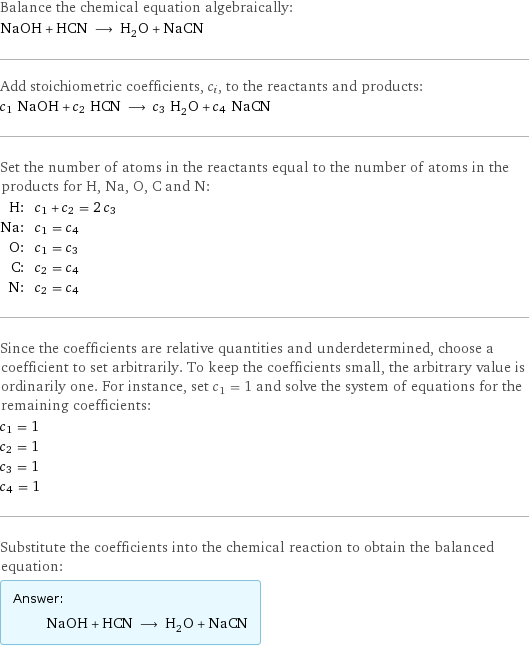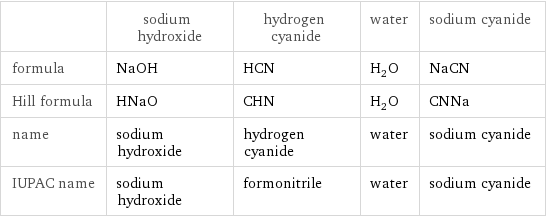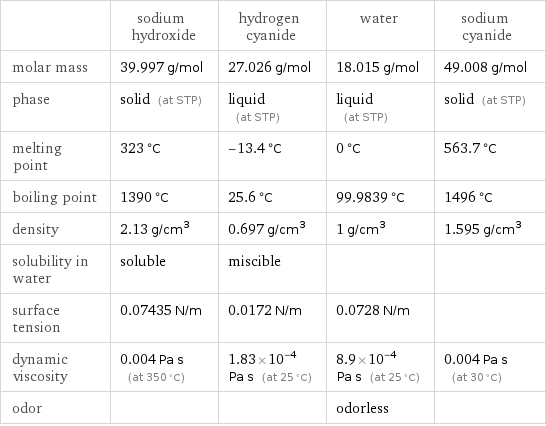Input interpretation

NaOH sodium hydroxide + HCN hydrogen cyanide ⟶ H_2O water + NaCN sodium cyanide
Balanced equation

Balance the chemical equation algebraically: NaOH + HCN ⟶ H_2O + NaCN Add stoichiometric coefficients, c_i, to the reactants and products: c_1 NaOH + c_2 HCN ⟶ c_3 H_2O + c_4 NaCN Set the number of atoms in the reactants equal to the number of atoms in the products for H, Na, O, C and N: H: | c_1 + c_2 = 2 c_3 Na: | c_1 = c_4 O: | c_1 = c_3 C: | c_2 = c_4 N: | c_2 = c_4 Since the coefficients are relative quantities and underdetermined, choose a coefficient to set arbitrarily. To keep the coefficients small, the arbitrary value is ordinarily one. For instance, set c_1 = 1 and solve the system of equations for the remaining coefficients: c_1 = 1 c_2 = 1 c_3 = 1 c_4 = 1 Substitute the coefficients into the chemical reaction to obtain the balanced equation: Answer: | | NaOH + HCN ⟶ H_2O + NaCN
Structures

+ ⟶ +
Names

sodium hydroxide + hydrogen cyanide ⟶ water + sodium cyanide
Equilibrium constant
![Construct the equilibrium constant, K, expression for: NaOH + HCN ⟶ H_2O + NaCN Plan: • Balance the chemical equation. • Determine the stoichiometric numbers. • Assemble the activity expression for each chemical species. • Use the activity expressions to build the equilibrium constant expression. Write the balanced chemical equation: NaOH + HCN ⟶ H_2O + NaCN Assign stoichiometric numbers, ν_i, using the stoichiometric coefficients, c_i, from the balanced chemical equation in the following manner: ν_i = -c_i for reactants and ν_i = c_i for products: chemical species | c_i | ν_i NaOH | 1 | -1 HCN | 1 | -1 H_2O | 1 | 1 NaCN | 1 | 1 Assemble the activity expressions accounting for the state of matter and ν_i: chemical species | c_i | ν_i | activity expression NaOH | 1 | -1 | ([NaOH])^(-1) HCN | 1 | -1 | ([HCN])^(-1) H_2O | 1 | 1 | [H2O] NaCN | 1 | 1 | [NaCN] The equilibrium constant symbol in the concentration basis is: K_c Mulitply the activity expressions to arrive at the K_c expression: Answer: | | K_c = ([NaOH])^(-1) ([HCN])^(-1) [H2O] [NaCN] = ([H2O] [NaCN])/([NaOH] [HCN])](../image_source/0e418ee2e73a20968aa428c5a1da2833.png)
Construct the equilibrium constant, K, expression for: NaOH + HCN ⟶ H_2O + NaCN Plan: • Balance the chemical equation. • Determine the stoichiometric numbers. • Assemble the activity expression for each chemical species. • Use the activity expressions to build the equilibrium constant expression. Write the balanced chemical equation: NaOH + HCN ⟶ H_2O + NaCN Assign stoichiometric numbers, ν_i, using the stoichiometric coefficients, c_i, from the balanced chemical equation in the following manner: ν_i = -c_i for reactants and ν_i = c_i for products: chemical species | c_i | ν_i NaOH | 1 | -1 HCN | 1 | -1 H_2O | 1 | 1 NaCN | 1 | 1 Assemble the activity expressions accounting for the state of matter and ν_i: chemical species | c_i | ν_i | activity expression NaOH | 1 | -1 | ([NaOH])^(-1) HCN | 1 | -1 | ([HCN])^(-1) H_2O | 1 | 1 | [H2O] NaCN | 1 | 1 | [NaCN] The equilibrium constant symbol in the concentration basis is: K_c Mulitply the activity expressions to arrive at the K_c expression: Answer: | | K_c = ([NaOH])^(-1) ([HCN])^(-1) [H2O] [NaCN] = ([H2O] [NaCN])/([NaOH] [HCN])
Rate of reaction
![Construct the rate of reaction expression for: NaOH + HCN ⟶ H_2O + NaCN Plan: • Balance the chemical equation. • Determine the stoichiometric numbers. • Assemble the rate term for each chemical species. • Write the rate of reaction expression. Write the balanced chemical equation: NaOH + HCN ⟶ H_2O + NaCN Assign stoichiometric numbers, ν_i, using the stoichiometric coefficients, c_i, from the balanced chemical equation in the following manner: ν_i = -c_i for reactants and ν_i = c_i for products: chemical species | c_i | ν_i NaOH | 1 | -1 HCN | 1 | -1 H_2O | 1 | 1 NaCN | 1 | 1 The rate term for each chemical species, B_i, is 1/ν_i(Δ[B_i])/(Δt) where [B_i] is the amount concentration and t is time: chemical species | c_i | ν_i | rate term NaOH | 1 | -1 | -(Δ[NaOH])/(Δt) HCN | 1 | -1 | -(Δ[HCN])/(Δt) H_2O | 1 | 1 | (Δ[H2O])/(Δt) NaCN | 1 | 1 | (Δ[NaCN])/(Δt) (for infinitesimal rate of change, replace Δ with d) Set the rate terms equal to each other to arrive at the rate expression: Answer: | | rate = -(Δ[NaOH])/(Δt) = -(Δ[HCN])/(Δt) = (Δ[H2O])/(Δt) = (Δ[NaCN])/(Δt) (assuming constant volume and no accumulation of intermediates or side products)](../image_source/920d52c1137218d9632b774d683517eb.png)
Construct the rate of reaction expression for: NaOH + HCN ⟶ H_2O + NaCN Plan: • Balance the chemical equation. • Determine the stoichiometric numbers. • Assemble the rate term for each chemical species. • Write the rate of reaction expression. Write the balanced chemical equation: NaOH + HCN ⟶ H_2O + NaCN Assign stoichiometric numbers, ν_i, using the stoichiometric coefficients, c_i, from the balanced chemical equation in the following manner: ν_i = -c_i for reactants and ν_i = c_i for products: chemical species | c_i | ν_i NaOH | 1 | -1 HCN | 1 | -1 H_2O | 1 | 1 NaCN | 1 | 1 The rate term for each chemical species, B_i, is 1/ν_i(Δ[B_i])/(Δt) where [B_i] is the amount concentration and t is time: chemical species | c_i | ν_i | rate term NaOH | 1 | -1 | -(Δ[NaOH])/(Δt) HCN | 1 | -1 | -(Δ[HCN])/(Δt) H_2O | 1 | 1 | (Δ[H2O])/(Δt) NaCN | 1 | 1 | (Δ[NaCN])/(Δt) (for infinitesimal rate of change, replace Δ with d) Set the rate terms equal to each other to arrive at the rate expression: Answer: | | rate = -(Δ[NaOH])/(Δt) = -(Δ[HCN])/(Δt) = (Δ[H2O])/(Δt) = (Δ[NaCN])/(Δt) (assuming constant volume and no accumulation of intermediates or side products)
Chemical names and formulas

| sodium hydroxide | hydrogen cyanide | water | sodium cyanide formula | NaOH | HCN | H_2O | NaCN Hill formula | HNaO | CHN | H_2O | CNNa name | sodium hydroxide | hydrogen cyanide | water | sodium cyanide IUPAC name | sodium hydroxide | formonitrile | water | sodium cyanide
Substance properties

| sodium hydroxide | hydrogen cyanide | water | sodium cyanide molar mass | 39.997 g/mol | 27.026 g/mol | 18.015 g/mol | 49.008 g/mol phase | solid (at STP) | liquid (at STP) | liquid (at STP) | solid (at STP) melting point | 323 °C | -13.4 °C | 0 °C | 563.7 °C boiling point | 1390 °C | 25.6 °C | 99.9839 °C | 1496 °C density | 2.13 g/cm^3 | 0.697 g/cm^3 | 1 g/cm^3 | 1.595 g/cm^3 solubility in water | soluble | miscible | | surface tension | 0.07435 N/m | 0.0172 N/m | 0.0728 N/m | dynamic viscosity | 0.004 Pa s (at 350 °C) | 1.83×10^-4 Pa s (at 25 °C) | 8.9×10^-4 Pa s (at 25 °C) | 0.004 Pa s (at 30 °C) odor | | | odorless |
Units
